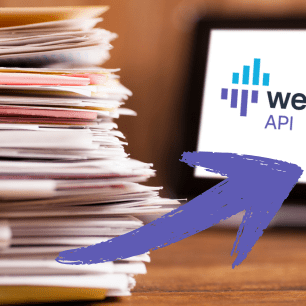Artificial Intelligence (AI): The Future of a better Fintech world
Artificial Intelligence (AI) and Machine Learning (ML): These cutting-edge technologies are shaping the future and are set to transform the financial landscape.
From enhancing customer support to boosting operational efficiency and developing groundbreaking products and services, the applications of AI and ML are vast. Let’s delve deeper into the potential and explore how wealthAPI is harnessing these technologies.

Artificial Intelligence (AI) and Machine Learning (ML) are transforming the financial services industry
Let’s face it, AI and ML can be pretty complex. Before we get into the nitty-gritty, let’s take a step back and get a basic understanding of these technologies.
Artificial Intelligence (AI): When machines exhibit human-like intelligence
AI systems possess the ability to learn from data, identify patterns, and autonomously refine their processes. This allows them to adapt to evolving circumstances and consistently enhance their performance.
AI’s ability to analyze complex problems, generate multiple solutions, and select the optimal one makes it a versatile tool across industries. In finance, it can enhance decision-making in areas such as lending, fraud detection, and wealth management by leveraging data-driven insights.
Machine Learning (ML): A subfield of artificial intelligence
Machine Learning, a subset of AI, concentrates on developing algorithms capable of learning from data without being explicitly programmed. The quality of the training data significantly impacts the model’s performance.
Imagine teaching a child how to play chess. You explain the rules, share some basic strategies, and then let them play against others. Over time, the child learns from their experiences, improves their gameplay, and becomes increasingly skilled. Machine learning works in a similar way: ML algorithms are trained on large datasets to independently recognize patterns and relationships. Based on these identified patterns, the algorithms can then make predictions or decisions. Unlike a child, however, an AI remembers all of its actions and their outcomes – forever.
To further illustrate the difference between AI and ML, consider a robot that can play chess. This robot is an AI system. However, the software used to teach the robot how to play chess employs machine learning techniques.
This is how AI and ML are used in finance
AI and ML are no longer just a vision of the future but are already a reality in the financial world. The implementation of these technologies offers enormous opportunities and opens up new ways to delight customers, optimize processes, and manage businesses more effectively. Companies that proactively address this challenge and use AI and ML responsibly will be the winners of the digital transformation.
This is how AI-powered chatbots and virtual assistants are becoming service representatives in customer service, available 24/7. They answer questions, solve problems, and provide real-time support. Based on customer profiles and behavior, they can offer personalized products and services. Early adopters, including companies and banks, are already using AI to assist customers with account opening, answering questions about products and services, and conducting transactions.
Machine learning optimizes processes, making them more cost-effective, efficient, and faster. Routine tasks such as account management, loan approval, and fraud prevention are automated through ML algorithms. This saves time, reduces costs, and allows employees to focus on more complex tasks. Real-world examples already exist that analyze transactions for anomalies and fraud attempts, blocking them in real time if necessary.
AI-powered analytics also provide valuable insights into customer behavior, market trends, and risk profiles. This enables companies to make informed decisions that increase their efficiency, open up new business areas, and expand their competitive advantage. With the help of ML, companies can develop new financial products and services tailored to the individual needs and preferences of their customers. This creates a new dimension of customer focus and satisfaction.
wealthAPI: Empowering personalized finance with AI and ML
wealthAPI leverages the cutting-edge capabilities of AI and ML to deliver tailored financial solutions that empower our partners. Our proprietary wealth-AI technology is the driving force behind these innovative offerings.
It’s an intelligent platform that utilizes real-time wealth and portfolio data to deliver highly personalized product recommendations.
Data aggregation and processing: The backbone of wealth-AI
We start by consolidating and preparing data from diverse sources. As a leading Kontoinformationsdienstleister, wealthAPI has access to a wealth of data, such as:
- Using current account data (PSD2), we’ve developed a , that offers our customers’ users a clear picture of their spending habits.
- Custodial account data:Contains details on holdings such as stocks, mutual funds, and exchange-traded funds.
- Historical data: Allows for the evaluation of previous investment returns.
- Contractual data:Allows for the identification of recurring payments, premium adjustments, and contract term lengths.
- Simulated portfolios: Our partners’ clients have the ability to test different investment strategies using simulated portfolios.
Training artificial intelligence models using anonymized dataset
Our AI is trained on completely anonymized but highly insightful data. This enables wealth-AI to discern patterns within the data and establish connections between different variables.
Currently, wealthAPI partners can offer personalized recommendations to their clients through a questionnaire. This questionnaire gathers information on investment horizon, sustainability, risk tolerance, and preferences regarding investment products. Based on this information, wealth-AI generates recommendations and shows how other users with similar preferences have invested.
Future vision: AI-powered performance analysis and wealth accumulation
This is just the beginning. In the future, we aim to further expand the capabilities of AI and ML. Our plans include:
- Analyzing individual portfolio performance: The AI will be able to analyze the performance of each individual client’s portfolio, comparing it to similar portfolios (peer group), and identifying potential areas for improvement.
- Integrating real estate values: wealthAPI plans to include real estate values in its analysis to provide users with a comprehensive overview of their assets.
- AI-powered wealth-building plans: wealthAPI will provide partners’ clients with AI-generated plans to help them achieve their financial goals.
wealthAPI’s vision is to create a transformative financial ecosystem where our partners can offer personalized financial products to their clients at the right time. To achieve this, we aim to become Europe’s leading platform for financial management and recommendations, powered by an intelligent, AI-driven recommendation platform. We are already the market leader in Germany.
wealthAPI Blog
wealthAPI becomes an extraordinary member of the Association of German Banks
The Association of German Banks (Bundesverband deutscher Banken e.V. - BdB) is the leading…
FiDA as an Opportunity: How Data-Driven Compliance Strengthens Financial Institutions
Since the publication of the European Commission's 2026 work program at the latest, FiDA has once…
From PSD2 to PSD3: Europe’s last chance to make Open Banking a success?
When the second Payment Services Directive (PSD2) was introduced in 2018, it promised a revolution…


